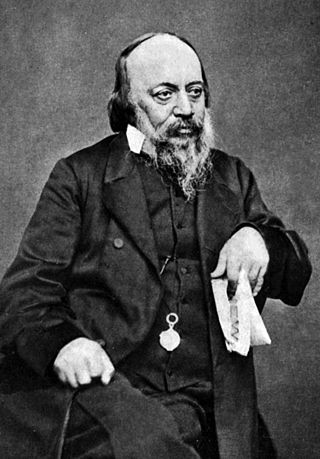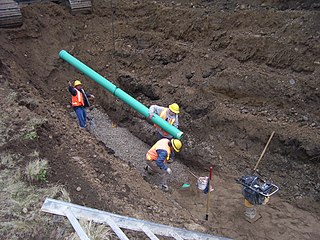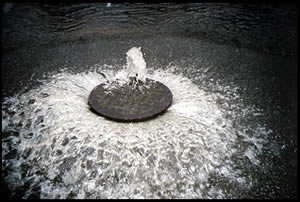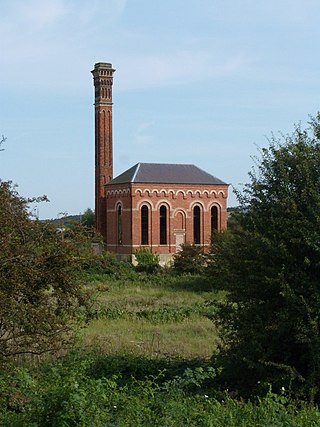
Sewerage is the infrastructure that conveys sewage or surface runoff using sewers. It encompasses components such as receiving drains, manholes, pumping stations, storm overflows, and screening chambers of the combined sewer or sanitary sewer. Sewerage ends at the entry to a sewage treatment plant or at the point of discharge into the environment. It is the system of pipes, chambers, manholes, etc. that conveys the sewage or storm water.

Sir Edwin Chadwick KCB was an English social reformer who is noted for his leadership in reforming the Poor Laws in England and instituting major reforms in urban sanitation and public health. A disciple of Utilitarian philosopher Jeremy Bentham, he was most active between 1832 and 1854; after that he held minor positions, and his views were largely ignored. Chadwick pioneered the use of scientific surveys to identify all phases of a complex social problem, and pioneered the use of systematic long-term inspection programmes to make sure the reforms operated as planned.

A sanitary sewer is an underground pipe or tunnel system for transporting sewage from houses and commercial buildings to a sewage treatment plant or disposal. Sanitary sewers are a type of gravity sewer and are part of an overall system called a "sewage system" or sewerage. Sanitary sewers serving industrial areas may also carry industrial wastewater. In municipalities served by sanitary sewers, separate storm drains may convey surface runoff directly to surface waters. An advantage of sanitary sewer systems is that they avoid combined sewer overflows. Sanitary sewers are typically much smaller in diameter than combined sewers which also transport urban runoff. Backups of raw sewage can occur if excessive stormwater inflow or groundwater infiltration occurs due to leaking joints, defective pipes etc. in aging infrastructure.

The London sewer system is part of the water infrastructure serving London, England. The modern system was developed during the late 19th century, and as London has grown the system has been expanded. It is currently owned and operated by Thames Water and serves almost all of Greater London.

Cesspit, cesspool and soak pit in some contexts are terms with various meanings: they are used to describe either an underground holding tank or a soak pit. A cesspit can be used for the temporary collection and storage of feces, excreta or fecal sludge as part of an on-site sanitation system and has some similarities with septic tanks or with soak pits. Traditionally, it was a deep cylindrical chamber dug into the ground, having approximate dimensions of 1 metre (3') diameter and 2–3 metres depth. Their appearance was similar to that of a hand-dug water well.
Sewage disposal regulation and administration describes the governance of sewage treatment and disposal.

The Great Stink was an event in Central London during July and August 1858 in which the hot weather exacerbated the smell of untreated human waste and industrial effluent that was present on the banks of the River Thames. The problem had been mounting for some years, with an ageing and inadequate sewer system that emptied directly into the Thames. The miasma from the effluent was thought to transmit contagious diseases, and three outbreaks of cholera before the Great Stink were blamed on the ongoing problems with the river.

The Milwaukee Metropolitan Sewerage District (MMSD) is a regional government agency that provides water reclamation and flood management services for about 1.1 million people in 28 communities in the Greater Milwaukee Area. A recipient of the U.S. Water Prize and many other awards, the District has a record of 98.4 percent, since 1994, for capturing and cleaning wastewater from 28 communities in a 411-square-mile (1,060 km2) area. The national goal is 85 percent of all the rain and wastewater that enters their sewer systems.

A combined sewer is a type of gravity sewer with a system of pipes, tunnels, pump stations etc. to transport sewage and urban runoff together to a sewage treatment plant or disposal site. This means that during rain events, the sewage gets diluted, resulting in higher flowrates at the treatment site. Uncontaminated stormwater simply dilutes sewage, but runoff may dissolve or suspend virtually anything it contacts on roofs, streets, and storage yards. As rainfall travels over roofs and the ground, it may pick up various contaminants including soil particles and other sediment, heavy metals, organic compounds, animal waste, and oil and grease. Combined sewers may also receive dry weather drainage from landscape irrigation, construction dewatering, and washing buildings and sidewalks.

First flush is the initial surface runoff of a rainstorm. During this phase, water pollution entering storm drains in areas with high proportions of impervious surfaces is typically more concentrated compared to the remainder of the storm. Consequently, these high concentrations of urban runoff result in high levels of pollutants discharged from storm sewers to surface waters.

Sanitary sewer overflow (SSO) is a condition in which untreated sewage is discharged from a sanitary sewer into the environment prior to reaching sewage treatment facilities. When caused by rainfall it is also known as wet weather overflow. Causes of sanitary sewer overflows include: Blockage of sewer lines, infiltration/Inflow of excessive stormwater into sewer lines during heavy rainfall, malfunction of pumping station lifts or electrical power failure, broken sewer lines. Prevention of such overflow events involves regular maintenance and timely upgrades of infrastructure.

The Deer Island Waste Water Treatment Plant is located on Deer Island, one of the Boston Harbor Islands in Boston Harbor. The plant is operated by the Massachusetts Water Resources Authority (MWRA) and began partial operations in 1995. The facility was fully operational in 2000 with the completion of the outfall tunnel.

Sanitary engineering, also known as public health engineering or wastewater engineering, is the application of engineering methods to improve sanitation of human communities, primarily by providing the removal and disposal of human waste, and in addition to the supply of safe potable water. Traditionally a branch of civil engineering and now a subset of environmental engineering, in the mid-19th century, the discipline concentrated on the reduction of disease, then thought to be caused by miasma. This was accomplished mainly by the collection and segregation of sewerage flow in London specifically, and Great Britain generally. These and later regulatory improvements were reported in the United States as early as 1865.

Effluent sewer systems, also called septic tank effluent gravity (STEG), solids-free sewer (SFS), or septic tank effluent drainage (STED) systems, have septic tanks that collect sewage from residences and businesses, and the liquid fraction of sewage that comes out of the tank is conveyed to a downstream receiving body such as either a centralized sewage treatment plant or a distributed treatment system for further treatment or disposal away from the community generating the sewage. Most of the solids are removed by the interceptor tanks, so the treatment plant can be much smaller than a typical plant and any pumping for the supernatant can be simpler without grinders.
Infiltration/Inflow is the process of groundwater, or water from sources other than domestic wastewater, entering sanitary sewers. I/I causes dilution in sanitary sewers, which decreases the efficiency of treatment, and may cause sewage volumes to exceed design capacity. Although inflow is technically different from infiltration, it may be difficult to determine which is causing dilution problems in inaccessible sewers. The United States Environmental Protection Agency defines the term infiltration/inflow as combined contributions from both.

The history of water supply and sanitation is one of a logistical challenge to provide clean water and sanitation systems since the dawn of civilization. Where water resources, infrastructure or sanitation systems were insufficient, diseases spread and people fell sick or died prematurely.

Ellis Sylvester Chesbrough (1813–1886) was an engineer credited with the design of the Chicago sewer system, which are sometimes known as the 'Chesbrough sewers'. This was the first comprehensive sewer system in the United States. He is responsible for the plan to raise Chicago, construction of the first water crib in Chicago, and designing the Boston water distribution system. The water system he designed for Chicago is on the National Register of Historic Places and has been designated a Historical Civil Engineering Landmark by the American Society of Civil Engineers.

A gravity sewer is a conduit utilizing the energy resulting from a difference in elevation to remove unwanted water. The term sewer implies removal of sewage or surface runoff rather than water intended for use; and the term gravity excludes water movement induced through force mains or vacuum sewers. Most sewers are gravity sewers; because gravity offers reliable water movement with no energy costs wherever grades are favorable. Gravity sewers may drain to sumps where pumping is required to either force sewage to a distant location or lift sewage to a higher elevation for entry into another gravity sewer, and lift stations are often required to lift sewage into sewage treatment plants. Gravity sewers can be either sanitary sewers, combined sewers, storm sewers or effluent sewers.

Lincoln Corporation Waterworks and its predecessors and successors have provided a public water supply and sewerage and sewage treatment services to the city of Lincoln, England. The Romans are known to have built a conduit from the Roaring Meg stream to a water tower in East Bight. Further development took place in 1846, when the Lincoln Water Company was established, following a national outbreak of cholera in 1831-32. The main source of supply was formed by impounding Prial Drain to form Hartsholme Lake. The water was filtered by sand filters at Boultham, and was pumped to a service reservoir at Westgate. Lincoln Corporation wanted to gain control of their water supply, and bought out the water company in 1871. The enabling Act of Parliament also allowed them to construct a sewerage network, which fed a sewage farm at Canwick, but the Bracebridge area was not connected to the sewers, and waste water polluted local watercourses. There were sporadic outbreaks of typhoid and cholera, although the Corporation argued that these might not be linked to a polluted water supply.

Worksop Waterworks Company, its predecessors and successors have provided a public water supply, together with sewerage and sewage treatment facilities to the town of Worksop since the mid-19th century. Unlike many towns, the sewerage network was constructed before the water supply network, and there was official opposition to the idea of providing a water supply network.